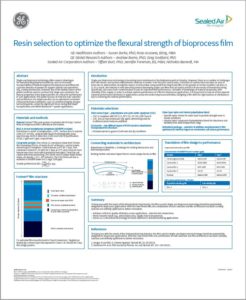 Abstract
Abstract
Single-use bioprocess technology offers several advantages for manufacturing biopharmaceuticals, such as increased transportability of fluids throughout the bioprocess workflow and a greater diversity of systems to support specific unit operations, e.g., rocking bioreactors. However, due to the flexible nature of the plastic materials used to construct the single-use containers, the flexural properties of the bioprocess film are critical for performance in such applications. This document focuses on how the resin selection and architecture of a bioprocess film can be optimized to maintain critical performance attributes, such as container integrity and gas barrier properties, under the significant forces during bulk liquid transportation and WAVE Bioreactor™ system applications.
Background
Single-use bioprocess technology is becoming more mainsteam in the biopharmaceutical industry. However, there are a number of challenges that still remain, and system requirements continue to evolve. Over the past several years, materials of construction has been an area of focus due to observations of negative impact of extractable compounds from bioprocess film on the growth of certain sensitive cell lines (1, 2). As a result, the industry is now advancing toward developing single-use films that are better suited to fit the needs of biomanufacturing. Specifically, end users have communicated a need for improved film performance, a breadth of knowledge of material properties, with reliability of the supply. In order to achieve optimal performance of a film for bioprocess applications, it is important to map all of the required material performance attributes in applications across the entire bioprocess workflow. Designing a film with the right balance of attributes is key to achieving the desired performance.
Summary
To keep pace with the needs of the biomanufacturing industry, the films used in single-use bioprocess technology should be purposefully designed for bioprocess applications. With the new Fortem film, the combination of resin selection and film architecture has been carefully selected and skillfully optimized to deliver innovation.
- Achieves critical to quality attributes across applications– selected data shown here.
- Meets industry needs (e.g., extractables data, supply chain transparency).
- Serves as a cornerstone technology for future advances in biomanufacturing applications.
